What is prototype?
- Create two objects which are unlinked:
const functionStore={
increment: function() {this.score++;}
login: function(){console.log("You are loggedin")}
}
const user1={
name:"Phil";
socre:4;
}
user1.name;//"Phil"
user1.increment// Error!
- Then make the link with Object.create();
const user1 = Object.create(functionStore);
user1; // { }
- solution:
const functionStore={
increment: function() {this.score++;},
login: function(){console.log("You are loggedin")}
}
const user1=Object.create(functionStore);
user1.name="Phil";
user1.score=4;
user1.increment();
- map it out
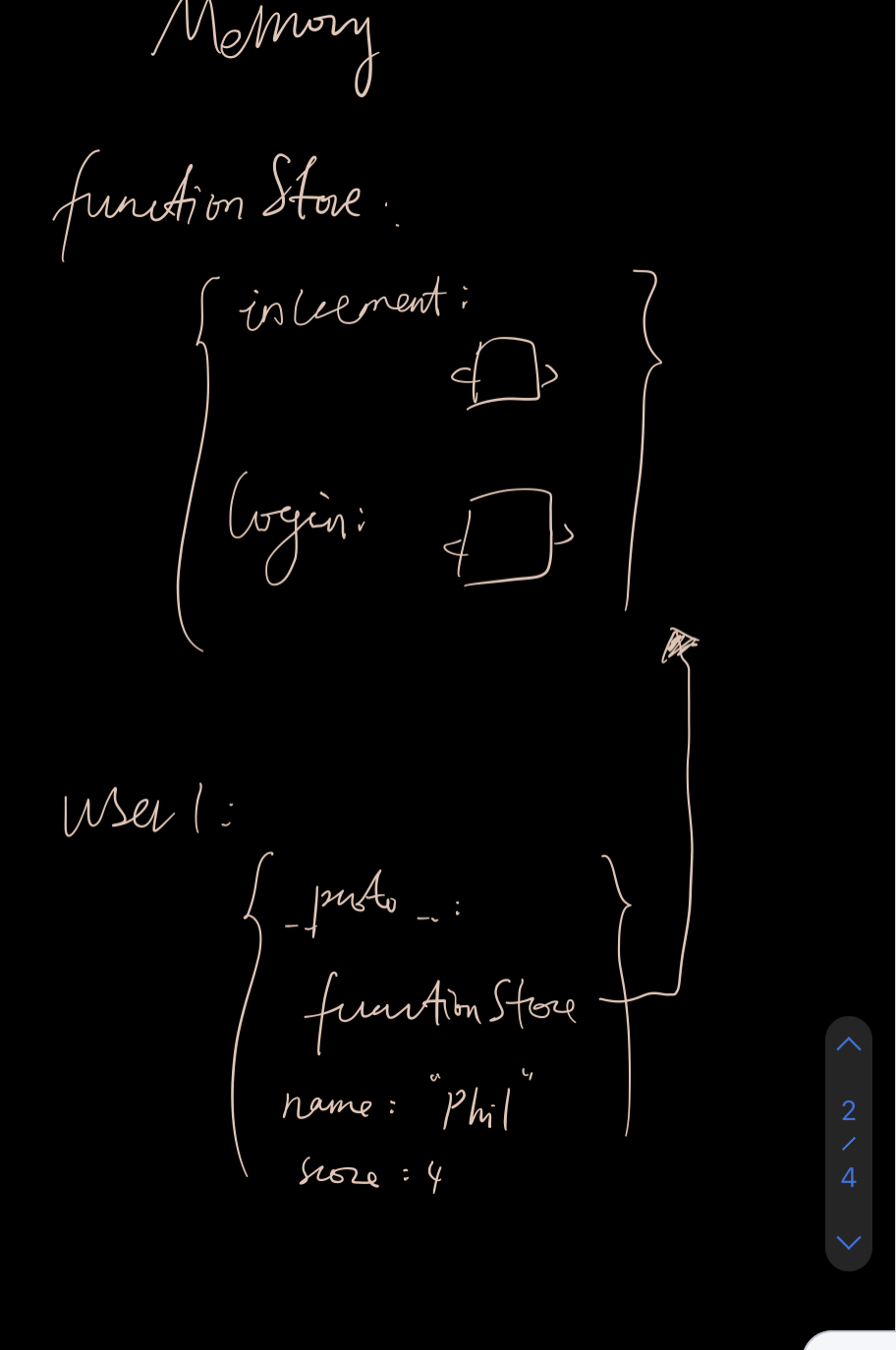
proto
- Creating objects using functions, without copying functions in every object repeatedly;
function userCreator(name, score) {
const newUser = Object.create(userFunctionStore);
newUser.name = name;
newUser.score = score;
return newUser;
}
const userFunctionStore = {
increment: function () {
this.score++;
},
login: function () {
console.log("You are loggedin");
},
};
const user1 = userCreator("Phil", 4);
const user2 = userCreator("Julia", 5);
user1.increment();
- verbalize the steps:
function userCreator(name,score){
// 1.create a new function stored in memory
//parameters which are name and score, in order to receive arguments(the actual values we pass in later)
//6. create a local execution context;
//7. in the local memory, the first parameter is assigned the argument "Phil";
//8. pass in the second argument 4;
const newUser= Object.create(userFunctionStore);
//9. whatever pass in, it would be an empty object first;
//now this object has a bond to the userFunctionStore in the global memory;
//add a hidden property underscore underscore proto (__proto__) to this object;
newUser.name=name;
newUser.score=score;
//10. add property of name contains value of the name parameter; same as score property;
return newUser;
//11. return the object out without the name(just the value of the newUser with no name) into the global constant; or, assign this object to a new global label called user1;
};
const userFunctionStore={
//2. declare a constant stored two properties;
increment: function(){this.score++;}
//3. first property is a function; in orther words, the object has a method called increment on it;
login:function(){console.log("You are loggedin");}
//4. second property is a function; or, the object has a method called login on it;
};
const user1= userCreator("Phil", 4);
//5. create a new constant called user1 stored the return value of calling the function userCreator with inputs "Phil" and 4;
const user2= userCreator("Julia",5);
//12. the return value of calling the function; //an object with a property name which would be "Julia" + a property score which would be 5 + a hidden bond to userFunctionStore;
user1.increment();
// 13. find th user1 in the global memory; not find the increment method in the user1 object;
// then find the hidden bond to userFunctionStore, find the increment method in the object;
- map it out

How to make this process more efficient?
-
Using new keyword to automate our manual work;
-
call the constructor function with new, we automate 2 things:
- create a new user obj;
- return a new user obj;
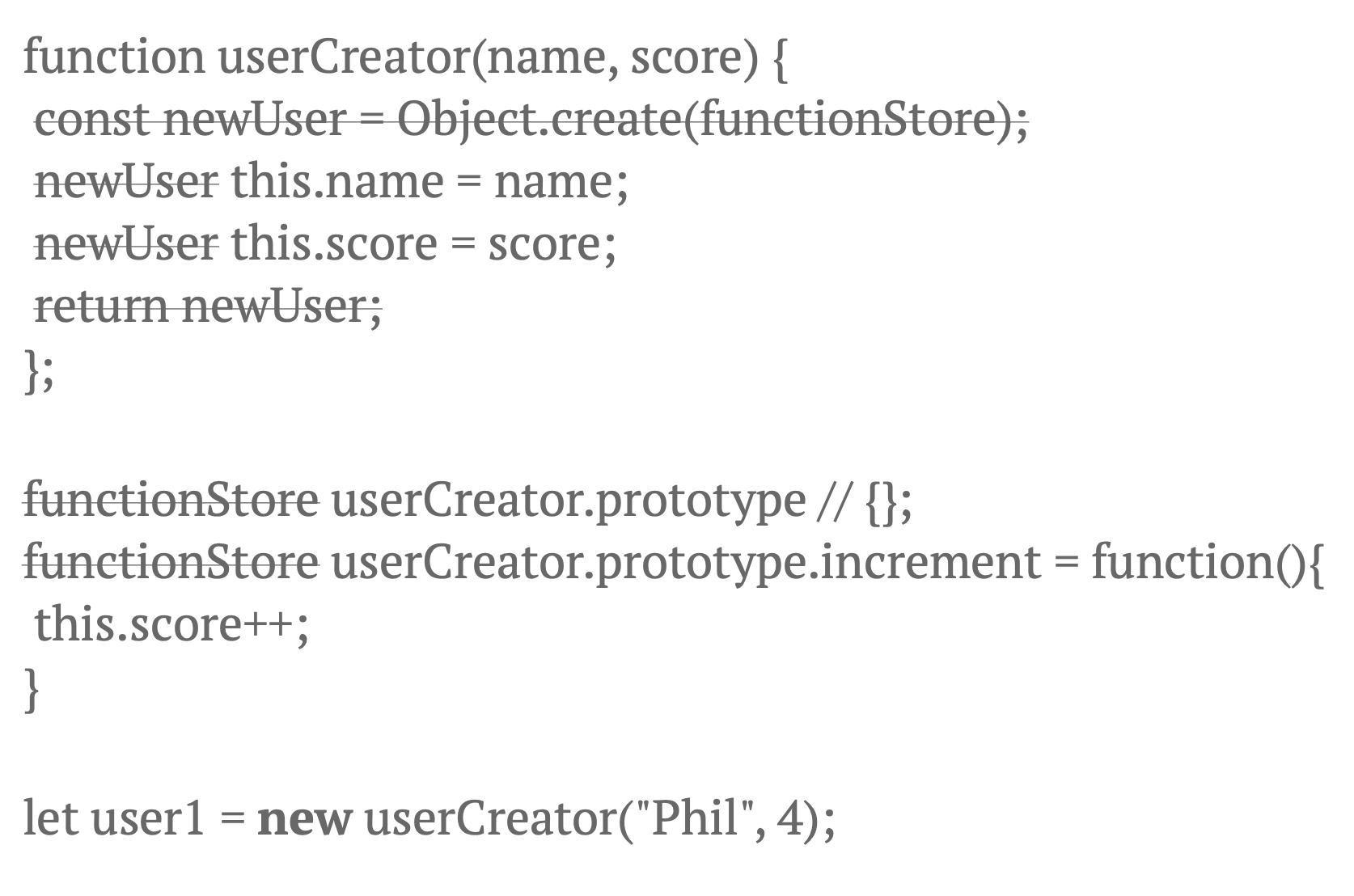
- map it out

- map it out
Note: the userCreator.prototype is a hidden property of userCreator called prototype.
How does the new keyword work under the hood?
Function-object combos
- meaning: all functions are both objects and functions;
- example:
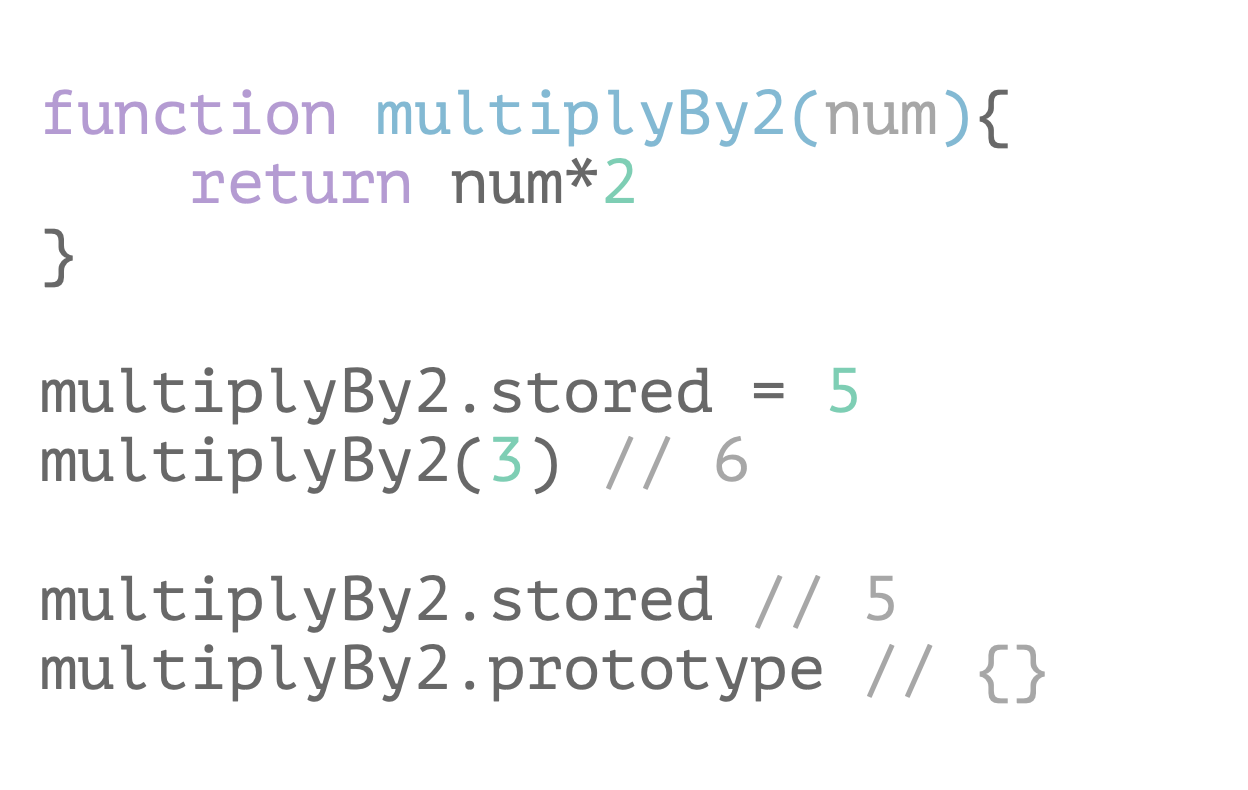
- we can access the object bit of a function and access the function bit at the same time, add property to the function does not overwrite it to be only object.
- We can use a dot notation to access its object bit in its function-object combo.
- prototype is a regular property of the function in its object form/ on a function in its object format, which is automatically an object.
Example using new and this
function UserCreator(name, score){
this.name=name;
this.score=score;
}
UserCreator.prototype.increment={
this.score++;
}
UserCreator.prototype.login={
console.log("login");
}
const user1= new UserCreator("Eva", 9);
user1.increment();
- verbalize the code in detail:
function UserCreator(name, score){
//1. create a new function with two parameters
//*true story: UserCreator is declared as a function-object combo
//and this object has by default a property called prototype which is an object automatically;
//the function bit can be accessed using parentheses in order to run the function;
// and the object bit can be accessed using dot notation;
// this object is used to store the single version of each of the functions we want;
//5.create local context and assign two arguements to the parameters;
//*then what the new key do automatically:
//-create an empty object and assign it to the label `this` in the local memory;
//-add a hidden property called proto, which has a bond to prototype/which is a reference to the prototype object/ a link to shared functions;
this.name=name;
this.score=score;
//6. find this, this is an auto created object,
//and assign the arguements to the property name and score;
//7. the new keyword auto-return the object,
// or, return the object with properties name and score out into the global label `user1` with a hidden bond to the prototype of UserCreator;
}
UserCreator.prototype.increment={
//2. JS looks for the UserCreator object first,
// then the property called prototype on the object form of this function, or this object-function combo,
//find the prototype property which is an object,
//and assign increment to this object, which is a method(function);
this.score++;
}
UserCreator.prototype.login={
//3. add a property in the prototype property on the function in its object format;
console.log("login");
}
const user1= new UserCreator("Eva", 9);
//4. declare a constant called user1 and the user1 is uninitialized for now,
//it gonna store the returning value of function called UserCreator with two inputs,
// while calling the UserCreator function, the new keyword mutates the execution context of the function,
//this context is gonna have a ton of stuff done automatically inside of it;
user1.increment();
//8. finally, the data and the functionality bundled together;
//9. find the user1 in global memory,
//but not find the property increment in user1 itself;
//10. look up in the proto property, which is a link to the prototype object on the UserCreator object(or function-object combo),
// then find the increment method in the prototype property of UserCreator;
- map it out
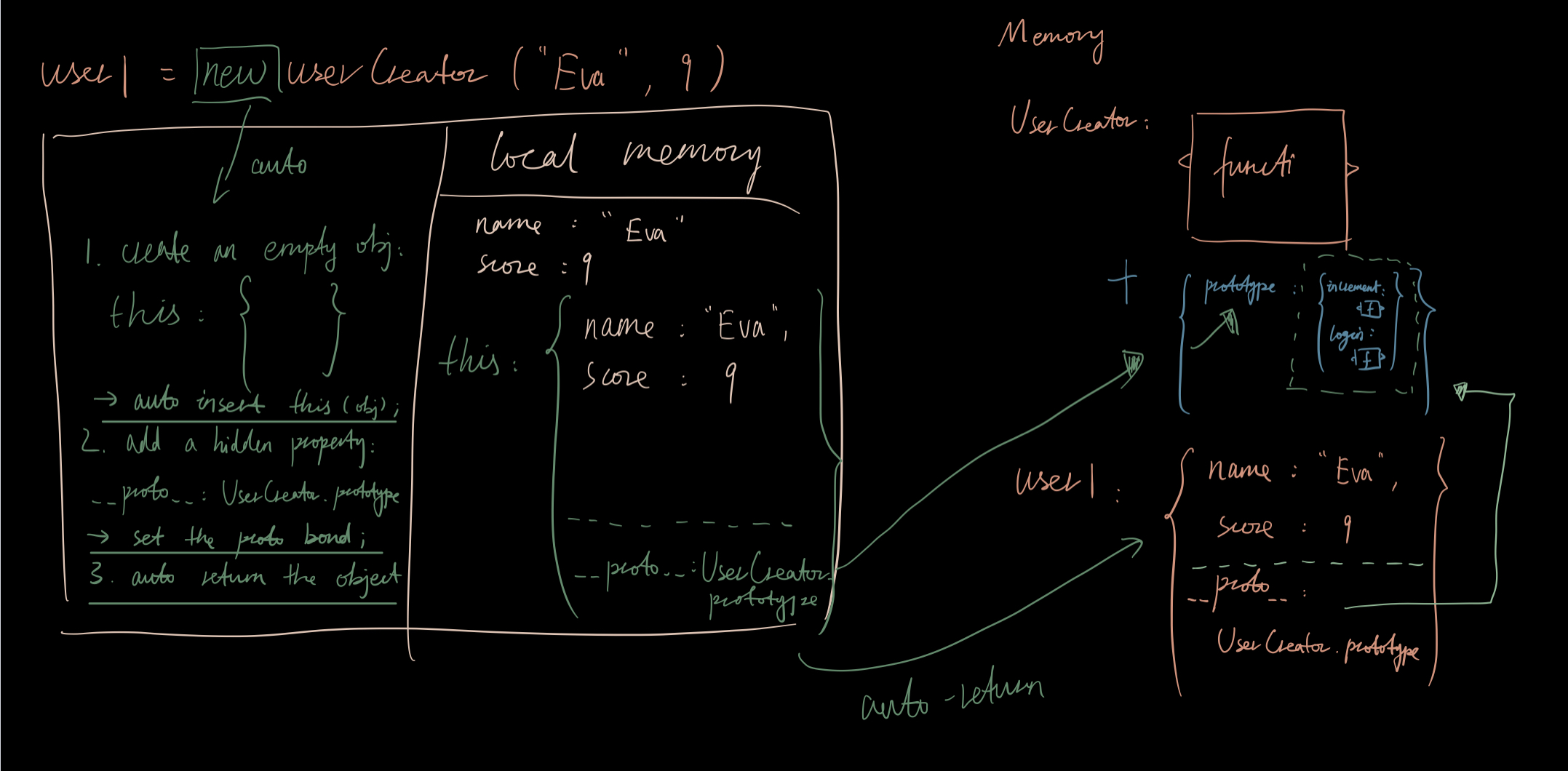
this keyword scoping issues
Define a new inner function to organize the code further- using traditional function expression or declaration.
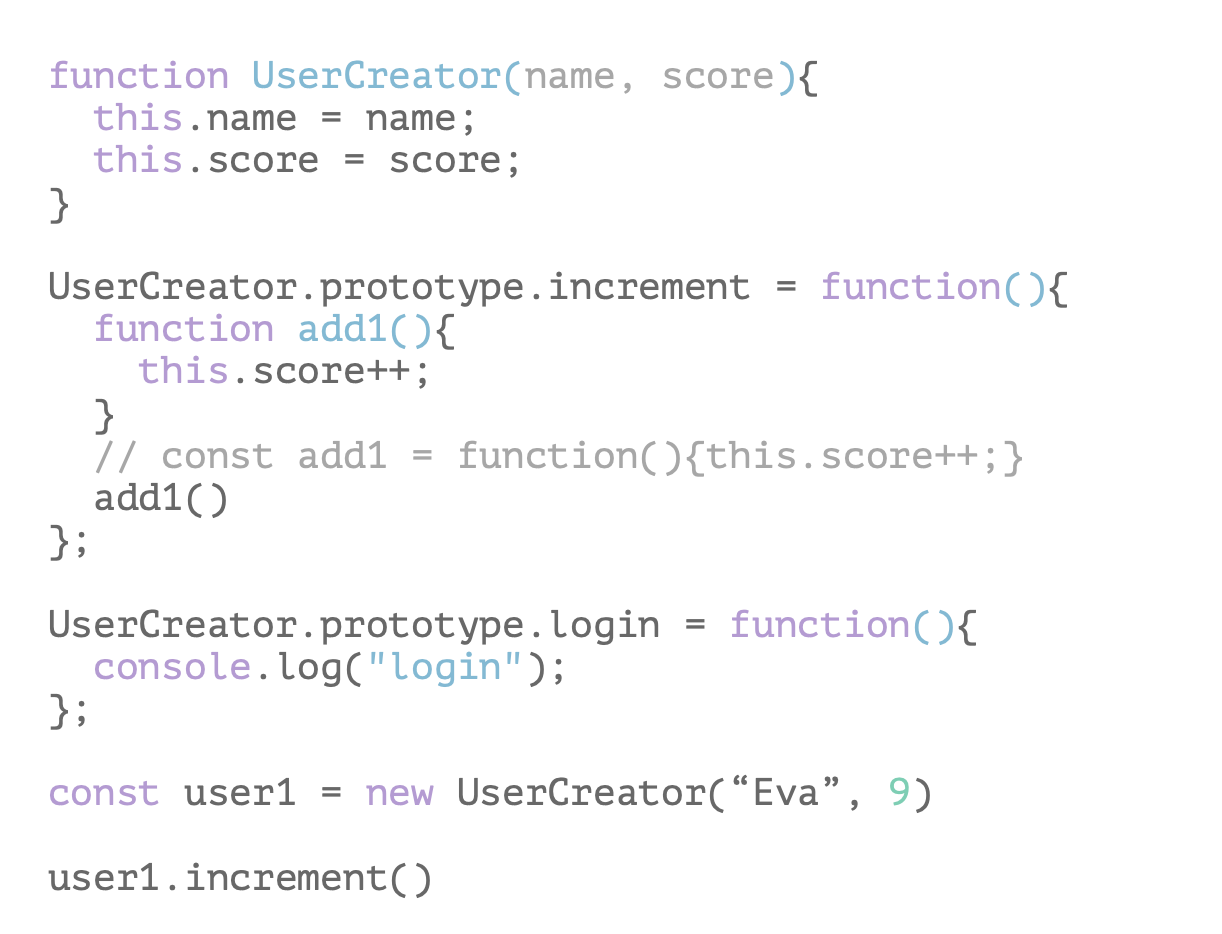
- this is WRONG
- this.score = window.score.
Solution:
-
using arrow functions to fix it

Problem explanation
this: an implicit parameter
-
this: allow us to refer to the pertinent object at hand; -
how to call the prototype method
function UserCreator(name, score) {
this.name = name;
this.score = score;
}
UserCreator.prototype.increment = function () {
this.score++;
};
UserCreator.prototype.login = function () {
console.log("You are loggedin!");
};
const user1 = new UserCreator("Eva", 9);
const user20 = new UserCreator("Jeff", 8);
user1.increment();
user20.increment();
- map it out

Rule of this
- a different
this: auto-created object. When we create the user1 with the keywordnew, the object was auto-created, and it got the labelthis, and then the object was returned out into user1, andthiswas gone, cause its execution context was deleted; - rule of using
this: the object at hand. Whenever I call a method, a function on an object, or I call a function to the right-hand side of the dot, as soon as that function’s execution context opens,thiswill automatically point to the object on the left-hand side of the dot.this, known as the implicit parameter in the local context, will be assigned to its implicit argument, meaning the object on the left-hand side of the dot.
Define a new inner function
- the traditional way: using function expression or function declaration;
- neither of which can give us the right
thisassignment inside (this waythispoints to window).
function UserCreator(name, score) {
this.name = name;
this.score = score;
}
UserCreator.prototype.increment = function () {
function add1() {
this.score++;
}
// const add1= function(){this.score++;}
//函数表达式等号赋值给变量,函数声明没有。两者区别是函数声明会提升作用域,函数表达式需要等赋值完毕才能调用。
add1();
};
UserCreator.prototype.login = function () {
console.log("You are loggedin!");
};
const user1 = new UserCreator("Eva", 9);
user1.increment();
- map it out

Solution explanation
Arrow function: a new way of declaring functions
-
Solving the bug in OOP: calling functions inside a method and the
thisinside refers to nothing we wanted,thisbeing miss assigned. -
benefits of Arrows:
thisassignment can be automatically static or lexical scoped, which meansthiscan automatically refers to thethisfrom where it was born (where it is saved in the local memory/ at hand).
With arrow functions- bind this lexically
function UserCreator(name, score) {
this.name = name;
this.score = score;
}
UserCreator.prototype.increment = function () {
const add1 = () => {
this.score++;
};
add1();
};
UserCreator.prototype.login = function () {
console.log("login");
};
const user1 = new UserCreator("Eva", 9);
user1.increment();
verbalize the code
-
The first thing in the local execution context is assigning the implicit parameter
this; -
thisis assigned to whatthiswas when functionadd1was defined, meaningadd1was saved as a label in memory for that function code with hidden stuff in it, including a hidden property saying whenadd1is called,thisassignment is to thethiswhenadd1was saved. -
Lexical static scoping: where I was born, where I am saved, determines sth about me when I get called, like
thisassignment. -
lexical means positioning on the page, where I was positioned.
map it out
